By Jigoro Kano and T. Lindsay, 1887
(Transactions of the Asiatic Society of Japan, Volume 15) 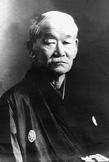 In feudal times in Japan, there were various military arts and exercises which the samurai classes were trained and fitted for their special form of warfare. Amongst these was the art of jujutsu, from which the present judo has sprung up. The word jujutsu may be translated freely as “the art of gaining victory by yielding or pliancy.” Originally, the name seems to have been applied to what may best be described as the art of fighting without weapons, although in some cases short weapons were used against opponents fighting with long weapons. Although it seems to resemble wrestling, yet it differs materially from wrestling as practiced in England, its main principle being not to match strength with strength, but to gain victory by yielding to strength. In feudal times in Japan, there were various military arts and exercises which the samurai classes were trained and fitted for their special form of warfare. Amongst these was the art of jujutsu, from which the present judo has sprung up. The word jujutsu may be translated freely as “the art of gaining victory by yielding or pliancy.” Originally, the name seems to have been applied to what may best be described as the art of fighting without weapons, although in some cases short weapons were used against opponents fighting with long weapons. Although it seems to resemble wrestling, yet it differs materially from wrestling as practiced in England, its main principle being not to match strength with strength, but to gain victory by yielding to strength. Since the abolition of the Feudal System the art has for some time been out of use, but at the present time it has become very popular in Japan, though with some important modifications, as a system of athletics, and its value as a method for physical training has been recognized by the establishment of several schools of jujutsu and judo in the capital. We shall first give an historical sketch of jujutsu, giving an account of the various schools to which it has given rise, and revert briefly in the sequel to the form into which it has been developed at the present time. Jujutsu has been known from feudal times under various names, such as yawara, tai-jutsu, kogusoku, kempo and hakuda. The names jujutsu and yawara were most widely known and used. In tracing the history of the art, we are met at the outset with difficulties which are not uncommon in similar researches–the unreliableness of much of the literature of the art. Printed books on the subject are scarce, and while there are innumerable manuscripts belonging to various schools of the art, many of them are contradictory and unsatisfactory. The originators of new schools seem often times to have made history to suit their own purposes, and thus the materials for a consistent and clear account of the origin and rise of jujutsu are very scanty. In early times, the knowledge of the history and the art was in the possession of the teachers of the various schools, who handed down information to their pupils as a secret in order to give it a sacred appearance. Moreover, the seclusion of one province from another, as a consequence of the Feudal System of Japan, prevented much acquaintance between teachers and pupils of thevarious schools, and thus contrary and often contradictory accounts of its history were handed down and believed. Further, it is to be noted that the interest of its students was devoted more to success in the practice of the art than to a knowledge of its rise and progress in the country.  Turning to the origin of jujutsu, as is to be expected various accounts are given. In the Bugei Sho-den, which is a collection of brief biographies of eminent masters of the different arts of fighting practiced in feudal times–accounts are given of kogusoku and ken, which is equivalent to kempo these two being distinguished from each other, the former as the art of seizing, and the latter as the art of gaining victory by pliancy. The art of kogusoku is ascribed to Takenouchi, a native of Sakushiu. It is said that in the first year of Tenbun, 1532, a sorcerer came unexpectedly to the house of Takenouchi and taught him five methods of seizing a man; he then went off and he could not tell whither he went. The origin of the art of ken is stated thus: There came to Japan from China a man named Chingempin, who left that country after the fall of the Min dynasty, and lived in Kokushoji (a Buddhist temple) in Azabu in Yedo, as Tokyo was then called. There also in the same temple lived three ronins, Fukuno, Isogai and Miura, One day Chingempin told them that in China there was an art of seizing a man, which he had seen himself practiced but had not learned its principles. On hearing this, these three men made investigations and afterwards became very skillful. The origin of ju, which is equivalent to jujutsu, is traced to these three men, from whom it spread throughout the country. In the same account the principles of the art are stated, and the following are their free translations: - Not to resist an opponent, but to gain victory by pliancy.
- Not to aim at frequent victory.
- Not to be led into scolding (bickering) by keeping the mind (empty) composed and calm.
- Not to be disturbed by things.
- Not to be agitated under any emergency but to be tranquil.
- And for all these, rules for respiration are considered important.
In the Bujutsu riu soroku, a book of biographies of the originators of different schools of the arts of Japanese warfare, exactly the same account is given of the origin of kogusoku, and a similar account of jujutsu; and it is also stated that the time in which Miura lived was about 1560. In the Chinomaki a certificate given by teachers of the Kito school to their pupils, we find a brief history of the art and its main principles as taught by that school. In it, reference is made to a writing dated the 11th year of Kuanbun (1671). According to it there was once a man named Fukuno who studied the art of fighting without weapons and so excelled in the art that he defeated people very much stronger than himself. The art at first did not spread to any great extent; but two of his students became especially noted, who were founders of separate schools, named Miura and Terada. The art taught by Miura was named wa (which is equivalent to yawara), and the art taught by Terada was named ju (which is equivalent to jujutsu). The date of the period in which Fukuno flourished is not mentioned in the certificate quoted above, but it is seen from the date in another manuscript that it must have been before the 1lth year of Kuanbun (1671). 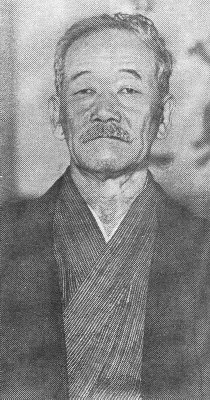 The Owari meisho dzue gives an account of Chingempin. According to it, Chingempin was a native of Korinken in China, who fled to Japan in order to escape from the troubles at the close of the Min dynasty. He was cordially received by the prince of Owari, and there died at the age of 85 in 1671, which is stated to be the date on his tombstone in Kenchuji in Nagoya. In the same book a passage is quoted from Kenpohisho which relates that when Chingempin lived in Kokushoji in Azabu, the three ronins Fukuno, Isogai and Miura also lived there, and Chingempin told them that in China there was an art of seizing a man and that he had seen it; that it was of such and such a nature. Finally these three men, after hearing this, investigated the art and as a result, the school of the art called kitoryu was founded. In a book called the Sen tetsu so dan, which may be considered one of the authorities on this subject, it is stated that Chingempin was born probably in the 15th year of Banreki according to Chinese chronology, that is in 1587; that he met at Nagoya, a priest named Gensei in the second year of Manji, that is in 1659, with whom he became very intimate. They published some poems under the title Gen Gen Sho Washu. In another book named Kiyu sho ran it is related that Chingempin came to Japan in the second year of Manji (1659). Again it is generally understood that Shunsui, a famous Chinese scholar, came to Japan on the fall of the Min dynasty in the second year of Manji (1659). From these various accounts it seems evident that Chingempin flourished in Japan some time after the second year of Manji, in 1659. So that the statement of the Bujutsu rusoroku that Miura flourished in the time of Eiroku must be discredited. It is evident from the accounts already given that Chingempin flourished at a later period., and that Miura was his contemporary. There are other accounts of the origin of jujutsu given by various schools of the art, to which we must now turn. The account given by the school named Yoshinryu is as follows: This school was begun by Miura Yoshin, a physician of Nagasaki in Hizen. He flourished in the early times of the Tokugawa shoguns. Believing that many diseases arose from not using mind and body together, he invented some methods of jujutsu. Together with his two medical pupils he found out 21 ways of seizing an opponent and afterwards found out 51 others. After his death his pupils founded two separate schools of the art, one of them naming his school Yoshinryu, from Yoshin, his teacher’s name; the other named his school Miuraryu, also from his teacher’s name. The next account is that of a manuscript named Tenjin Shinyoryu Taiiroku. In it there occurs a conversation between Iso Mataemon, the founder of the Tenjin Shinyoryu, and Terasaki, one of his pupils. The origin of jujutsu is related thus: There once lived in Nagasaki a physician named Akiyama, who went to China to study medicine. There he learned an art called hakuda which consisted of kicking and striking, differing, we may note, from jujutsu, which is mainly seizing and throwing. Akiyama learned three methods of this hakuda and 28 ways of recovering a man from apparent death. When he returned to Japan, he began to teach this art, but as he had few methods, his pupils got tired of it, and left him. Akiyama, feeling much grieved on this account, went to the Tenjin shrine in Tsukushi and there worshipped for 100 days. In this place he discovered 303 different methods of the art. What led to this is equally curious. One day during a snowstorm he observed a willow tree whose branches were covered with snow. Unlike the pine tree, which stood erect and broke before the storm, the willow yielded to the weight of snow on its branches, but did not break under it. In this way, he reflected jujutsu must be practiced. So he named his school Yoshinryu, the spirit of the willow-tree-school. In the Taiiroku it is denied that Chingempin introduced jujutsu into Japan-but while affirming that Akiyama introduced some features of the art from China, it adds, “it is a shame to our country” to ascribe the origin of jujutsu to China. In this opinion we ourselves concur. It seems to us that the art is Japanese in origin and development for the following reasons: - An art of defense without weapons is common in all countries in a more or less developed state, and in Japan the feudal state would necessarily develop jujutsu.
- The Chinese kempo and Japanese ju-jutsu differ materially in their methods.
- The existence of a similar art is referred to, before the time of Chingempin.
- The unsatisfactoriness of the accounts given of its origin.
- The existence of Japanese wrestling from very early times, which in some respects resembles jujutsu.
- As Chinese arts and Chinese civilizations were highly esteemed by the Japanese, in order to give prestige to the art, jujutsu may have been ascribed to a Chinese origin.
- In ancient times teachers of the different branches of military arts, such as fencing, using the spear, etc., seem to have practiced this art to some extent.
In support of this position, we remark first that jujutsu, as practiced in Japan, is not known in China. In that country there is the art before referred to called kempo, and from the account of it in a book named Kikoshinsho, it seems to be a method of kicking and striking. But jujutsu involved much more, as has been already made clear. Besides, a student in China, according to the books of instruction, is expected to learn and practice the art by himself, while in jujutsu it is essential that two men shall practice together. 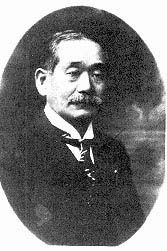 Although we admit that Chingempin may have introduced kempo to Japan, it is extremely difficult to look upon jujutsu in any sense a development of kempo. Besides, if Chingempin had been skilled in the art, it is almost certain that he would have referred to it in his book of poems which, along with Gensei, the priest with whom he became intimate at the castle of Nagoya, he published under their joint names as the Geugenshowashiu. Yet there is no reference in any of his writings to the art. Apart from Chingempin, the Japanese could learn something of the art of kenpo as practiced in China from books named Bubishi, Kikoshinsho, etc. We believe then that jujutsu is a Japanese art, which could have been developed to its present perfection without any aid from China, although we admit that Chingempin, or some Chinese book in kenpo may have given a stimulus to its development. Having thus discussed in a brief way the origin of jujutsu, and what jujutsu is in general way, we shall now turn to the different schools and the differences which are said to exist between the several names of the art mentioned above. It is impossible to enumerate all the schools of jujutsu; we might. count by hundreds, because almost all the teachers who have attained some eminence in the art have originated their own schools. We shall be satisfied here by referring to some of the most important on account of the principles taught, and the large number of pupils they have attracted. - Kitoryu or Kito School. This school is said to have been originated by Terada Kanemon. The time when he flourished is not given in any authoritative book or manuscript, but we may say he flourished not very long after Fukuno, because it is stated both in the Chinomaki of the kito school, and in the bujutsu riusoroku that he learned the art from another Terada, who was a pupil of Fukuno, although there are opinions contradictory to this statement. Among the celebrated men of this school may be mentioned Yoshimura, Hotta, Takino, Gamo, Imabori; and of late Takenaka, Noda, Iikubo, Yoshida and Motoyama, of whom the two last are still living.
- Kushinryu was originated by Inugami Nagakatsu. His grandson Inugami Nagayasu, better known as Inugami Gunbei, attained great eminence in the art and so developed it that he has been called in later times the originator of kushinryu. There is great similarity in the principles of the kitoryu and kushiuryu. The resemblance is so close, that we suppose the latter has been derived from the former. It is also said that in the second year of Kioho (1717) Inugami studied kitoryu under Takino. This must of course be one of the reasons why they are so similar. Among those who were famous in this school may be mentioned Ishino Tsukamato and Eguchi.
- Sekiguchi Jushin was an originator of another school. His school was called Sekiguchi ryu, after him. He had three sons, all of whom became famous in the art. Shibukawa Bangoro, Who studied the art from his first son Sekiguchi Hachirozaemon, became the founder of another great school of jujutsu known after him as the Shibukawaryu. Sekiguchi Jushin of the present time is a descendant of the originator (being of the ninth generation from him). Shibukawa Bangoro, the eighth descendant of the originator of Shibukawaryu, is now teaching his art at Motomachi in Hongo in Tokyo.
- The Yoshinryu. As has been stated above, there are two different accounts of the origin of this school. But on examining the manuscripts and the methods of those two schools, one of which traces the originator to Miura Yoshin and the other to Akiyama Shirobei, the close resemblances of the accounts lead to the belief that both had a common origin. The representative of Yoshinryu of Miura Yoshin at present is Totsuka Eibi, who is now teaching at Chiba, near Tokyo. His father was Totsuka Hikosuke, who died but two years ago. This man was one of the most celebrated masters of the art of late years. His father, Hikoyemon, was also very famous in the time he flourished. He studied his art under Egami Kauanriu, who made a profound investigation of the subject and was called the originator of Yoshinryu in later times. This man is said to have died in 1795. Another famous master of this school was Hitotsuyanagi Oribe. The Yoshinryu art which this man studied is the one which is said to have come from Akiyama.
- Tenjin Shinyoryu. This school was originated by Iso Mataemon, who died but 26 years ago. He first studied Yoshinryu under Hitotsuyanagi Oriye and then shin no shinto ryu (one of the schools of jujutsu which has developed out of Yoshinryu) from Homma Joyemon, He then went to different parts of the country to try his art with other masters, and finally formed a school of his own and named it tenjin shinyoryu. His school was at Otamagaike in Tokyo. His name spread throughout the country and he was considered the greatest master of the time. His son was named Iso Mataichiro. He became the teacher of jujutsu in a school founded by one of the Tokugawa shoguns for different arts of warfare. Among the famous pupils of Mataemon may be mentioned Nishimura, Okada, Yamamoto, Matsunaga and Ichikawa.
We have mentioned different names, such as jujutsu, yawara, tai-jutsu, kempo, hakuda, kogusoku. They are sometimes distinguished from one another, but very often applied to the art generally. For the present, without entering into detailed explanations of those names, we shall explain in a concise way what is the thing itself which these names come respectively to stand for. 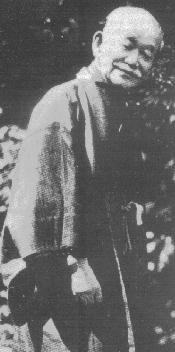 Jujutsu is an art of fighting without weapons and sometimes with small weapons much practiced by the samurai, and less generally the common people in the times of the Tokugawas. There are various ways of gaining victory, such as throwing heavily on the ground; choking up the throat; holding down on the ground or pushing to a wall in such a way that an opponent cannot rise up or move freely; twisting or bending arms, legs or fingers in such a way that an opponent cannot bear the pain, etc. There are various schools, and some schools practice all these methods and some only a few of them. Besides these, in some of the schools special exercises, called atemi and kuatsu, are taught. Atemi is the art of striking or kicking some of the parts of the body in order to kill or injure the opponents. Kuatsu, which means to resuscitate, is an art of resuscitating those who have apparently died through violence. The most important principle of throwing as practiced was to disturb the center of gravity of the opponent, and then pull or push in a way that the opponent cannot stand, exerting skill rather than strength, so that he might lose his equilibrium and fall heavily to the ground. A series of rules was taught respecting the different motions of feet, legs, arms, hands, the thigh and back, in order to accomplish this object. Choking up the throat was done by the hands, forearms, or by twisting the collar of the opponent’s coat round the throat. For holding down and pushing, any part of the body was used. For twisting and bending, the parts employed were generally the arms, hands and fingers, and sometimes the legs. The kuatsu or art of resuscitating is considered a secret; generally only the pupils and those who have made some progress in the art receive instruction. It has been customary with those schools where kuatsu is taught for teachers to receive a certain sum of money for teaching. And the pupils were to be instructed in the art after taking an oath that they never reveal the art to any one, even to parents and brothers. The methods of kuatsu are numerous and differ greatly in the different schools. The simplest is that for resuscitating those who have been temporarily suffocated by choking up the throat. There are various methods for doing this, one of which is to embrace the patient from the back and placing those edges on the palms of both hands which are opposite the thumb to the lower part of the abdomen to push it up towards the operator’s own body with those edges. The other kinds of kuatsu are such as recovering those who have fallen down from great heights and those who have been strangled, those who had been drowned, those who had received severe blows, etc. For these more complicated methods are employed. 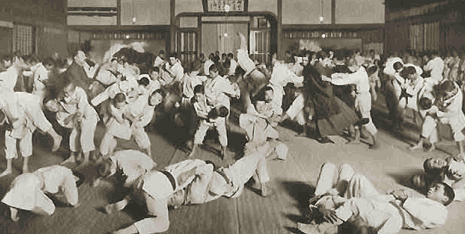
While the old form, jujutsu, was studied solely for fighting purposes, Kano’s new system is found to promote the mental as well as the physical faculties. While the old schools taught nothing but practice, the modern Judo gives the theoretical explanation of the doctrine, at the same time giving the practical a no less important place.
…..T. Shidachi, 1892

|